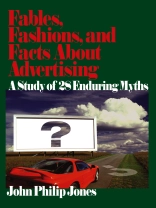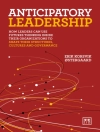‘The book makes an interesting and substantive contribution to the field of advertising directly, and also to the entire field of marketing communications or promotion. John Philip Jones presents a new and informed perspective that supports and underpins the need for advertising that works rather than emotive rhetoric that obscures its purpose and function.’
–Philip J. Kitchen,
University of Hull, U.K.
‘This is a much needed text that puts misinformation to rest with strong evidence to disprove it. Most texts simply show how ads are developed, media plans are implemented, and lots of beautiful advertisements. This book shows how advertising can be and should be effective.’
–Jan S. Slater,
Ph.D., Ohio University
The workings of advertising have always remained a bit of a mystery; until about 1960 virtually nothing of the effectiveness of advertising was known. There was even some doubt about whether advertising worked at all. In the absence of facts, theories were developed up to fill the vacuum. These were soon developed into doctrines, which became widely followed—fables that became fashions. Not many of these theories were ever subjected to harsh scrutiny based on factual knowledge, mainly because there was not much factual knowledge available until recently.
John Philip Jones, bestselling author and internationally known advertising scholar, has written a textbook to help evaluate these advertising ‘fables’ and ‘fashions, ‘ and also to study the facts. He uses the patterns and trends revealed by the accumulations of data from cutting-edge research to illustrate the occasional incompleteness, inadequacy, and in some cases total wrongheadedness of these fables and fashions. Each chapter then attempts to describe one aspect of how advertising really works.
Unlike most other advertising textbooks,
Fables, Fashions, and Facts About Advertising is not written as a ‘how to’ text, or as a vehicle for war stories, or as a sales pitch. Instead, it is a book that concentrates solely on describing how advertising works. Written to be accessible to the general public with little or no experience studying advertising, it makes the scholarship of an internationally renowned figure accessible to students taking beginning advertising courses.
Fables, Fashions, and Facts About Advertising is ideal as a core or supplemental text for courses in marketing, communication, journalism, and related disciplines. This volume should also be useful to the tens-of-thousands of business people whose careers are directly or indirectly concerned with advertising.
Cuprins
Epigraph
Foreword
Acknowledgments
Advertising′s Relationship to Business Generally and the Consumer
Chapter 1 Why Advertisers Advertise
Commonsense and Its Pitfalls
Consumer Orientation
One Voice, Many Voices
Chapter 2 Overpromise and Underdelivery
Advertising and the Consumer
Advertising and the Amateur Experts
The Role of Habit
Chapter 3 Added Values
Products and Brands
Functionality
Added Values – The Result of Planning or Coincidence?
A Lesson from Economics
Longevity
Advertising Strategy and the Difficulty of Locating Target Consumers: The Development of Creative Ideas; and Facts About How Much Advertising Produces an Effect
Chapter 4 ‘Why Exactly Am I Spending All This Money?
Ends and Means
Sources of Business
Knitting Together a Brand′s Strategy
Chapter 5 How Many Fish Are There in the Pool? And Where Are They?
Mass Marketing – and the Search for Precision
The Reality of the Marketplace
Where Are the Fish Swimming in the Pool?
Chapter 6 The Advertising Imagination
Advertising′s Patchy Performance
The Causes of the Trouble
‘Bisociation’
Two Grab Bags
The Locked Strong Box
Chapter 7 Bursting the Dam Wall
The Imaginary Dam
Measuring How Advertising Produces Sales
The Effect of Increased Pressure
Are Diminishing Returns Universal?
Advertising Investments, Promotional Expenditures, Media Strategy and Media Tactics
Chapter 8 Overspending and Underspending
‘Gut’ Feel, Opportunism, Extravagance
Spending What a Firm Can Afford
Fact-Based Judgment
A Balancing Act
Chapter 9 Margins and How to Slice Into Them
The Pipeline
Pull Gives Way to Push
The Balance Tips Below the Line
Why Many Manufacturers Like Promotions – and Why They Are Usually Misled
Chapter 10 Fishing in Different Parts of the Pool
A Branch of Show Business
Do Media That Attract the Most Advertising Dollars Have the Greatest Horsepower to Produce Sales?
Does Television Reach All the Fish in the Pool?
Chapter 11 Regularity and Frequency
Media Planning: Fashions and Anachronisms
Two Traps for the Unwary
The State of the Media Art
How Advertising Works
Chapter 12 The Gatekeeper
Market Research: Transparency and Opacity
Good Cooks Make Biryani
Two Very Different Theories
Chapter 13 The Main Source of a Manufacturer′s Profit
Lessons from a Visit to a Supermarket
Added Values – What Advertising Contributes
Researching Advertising – Before and After It Is Run
Chapter 14 Looking Before You Leap
Research and the Creative Process
The Emergence of the Focus Group
A Last-Minute Health Check
Chapter 15 Consumer Perceptions – and the Cash Register
Why Do Advertisers Track Consumer Perceptions?
Consumer Perceptions of Advertising
Consumer Perceptions of Brands
A Footnote on Sales Promotions
Chapter 16 Wheels and Their Reinvention
An Abandoned Heritage
Is Direct Response an Exclusively Specialist Technique?
IMC – Does It Have a Promising Future Behind It?
How Advertising Is Managed
Chapter 17 The Global Village
Different Tribes
A Brand′s Position on Its Competitive
The Role of the Advertising Agency
Chapter 18 The Cinderella of Business
Advertising and the CEO – a Faded Relationship
Two Cultures
The Straitjacket
Does Advertising Matter?
Chapter 19 Volcanoes and Their Extinction
A Fascinating and Rather Sinister Business
Agencies on the Big Board Three Items for an Advertising Agencies on the Big Board Three Items for an Advertising Agencies on the Big Board
Three Items for an Advertising Agency′s Agenda
Sources of Information
Chapter 20 The Expanding Universe of Information
A Small Corpus of Valuable Literature
Chapters and Sources
Bibliography
Glossary
About the Author
Despre autor
John Philip Jones entered academe in 1981 after a 25-year career in advertising with J. Walter Thompson in Europe, is a tenured Professor in the Newhouse School at Syracuse University, and was Chairman of the Advertising Department for seven years. He has published ten books on advertising and numerous journal articles, and his work has been translated into German, Spanish, Japanese, Korean, Chinese, Portuguese, Turkish and Arabic. In 1991, John Philip Jones was named by the American Advertising Federation as the Distinguished Advertising Educator of the Year. In the same year he became a member of the Council of Judges of the Advertising Hall of Fame. In 1994, he was elected a member of the National Advertising Review Board. In 1996, he received a major award from Cowles Business Media and the American Association of Advertising Agencies for leadership in the media field. There were two prize winners, the other being NBC Sports. He received the Telmar Award in 1997, for extending the concept of Short-Term Advertising Strength (STAS) from television to print media. In 2001, he received the Syracuse University Chancellor’s Citation for Exceptional Academic Achievement.












